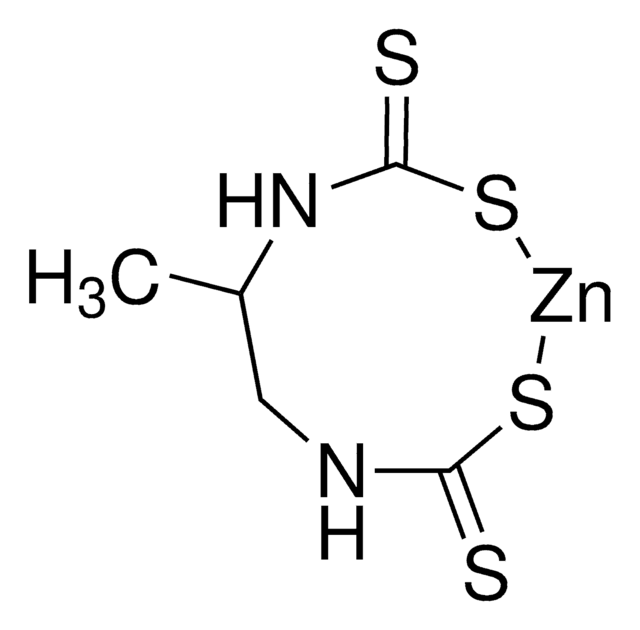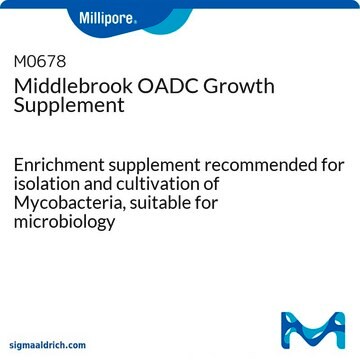49767
Glicerol
BioUltra, for molecular biology, anhydrous, ≥99.5% (GC)
Sinónimos:
1,2,3-Propanotriol, Glicerina
About This Item
Productos recomendados
grado
for molecular biology
Nivel de calidad
densidad de vapor
3.1 (vs air)
presión de vapor
<1 mmHg ( 20 °C)
Línea del producto
BioUltra
Análisis
≥99.5% (GC)
formulario
viscous liquid
temp. de autoignición
698 °F
impurezas
DNases, none detected
RNases, none detected
insoluble matter, passes filter test
phosphatases, none detected
proteases, none detected
residuo de ign.
≤0.1%
índice de refracción
n20/D 1.474 (lit.)
n20/D 1.474
pH
5.5-8 (25 °C, 5 M in H2O)
bp
182 °C/20 mmHg (lit.)
mp
20 °C (lit.)
solubilidad
H2O: 5 M at 20 °C, clear, colorless
densidad
1.25 g/mL (lit.)
trazas de anión
chloride (Cl-): ≤1 mg/kg
sulfate (SO42-): ≤10 mg/kg
trazas de catión
Ag: ≤5 mg/kg
Al: ≤1 mg/kg
As: ≤0.1 mg/kg
Ba: ≤1 mg/kg
Bi: ≤1 mg/kg
Ca: ≤5 mg/kg
Cd: ≤1 mg/kg
Co: ≤1 mg/kg
Cr: ≤1 mg/kg
Cu: ≤1 mg/kg
Fe: ≤1 mg/kg
K: ≤20 mg/kg
Li: ≤1 mg/kg
Mg: ≤1 mg/kg
Mn: ≤1 mg/kg
Mo: ≤1 mg/kg
NH4+: ≤5 mg/kg
Na: ≤20 mg/kg
Ni: ≤1 mg/kg
Pb: ≤1 mg/kg
Sr: ≤1 mg/kg
Tl: ≤5 mg/kg
Zn: ≤1 mg/kg
cadena SMILES
OCC(O)CO
λ
5 M in H2O
Absorción UV
λ: 260 nm Amax: 0.05
λ: 280 nm Amax: 0.07
InChI
1S/C3H8O3/c4-1-3(6)2-5/h3-6H,1-2H2
Clave InChI
PEDCQBHIVMGVHV-UHFFFAOYSA-N
¿Está buscando productos similares? Visita Guía de comparación de productos
Categorías relacionadas
Descripción general
Aplicación
Acciones bioquímicas o fisiológicas
- a supplement during cell culture of Mycobacterium tuberculosis and Mycobacterium avium.
- a fuel during designing enzymatic biofuel cell.
- a liquid composite matrix with 4-HCCA and 3-aminoquinoline for analysis of neutral and acidic glycans.
- a matrix for fast atom bombardment MS.
- may be employed as liquid matrix for the quantification studies by MALDI (Matrix-assisted laser desorption/ionization mass spectrometry) analysis.
Otras notas
Código de clase de almacenamiento
10 - Combustible liquids
Clase de riesgo para el agua (WGK)
WGK 1
Punto de inflamabilidad (°F)
390.2 °F - Pensky-Martens closed cup
Punto de inflamabilidad (°C)
199 °C - Pensky-Martens closed cup
Equipo de protección personal
Eyeshields, Gloves
Certificados de análisis (COA)
Busque Certificados de análisis (COA) introduciendo el número de lote del producto. Los números de lote se encuentran en la etiqueta del producto después de las palabras «Lot» o «Batch»
¿Ya tiene este producto?
Encuentre la documentación para los productos que ha comprado recientemente en la Biblioteca de documentos.
Los clientes también vieron
Nuestro equipo de científicos tiene experiencia en todas las áreas de investigación: Ciencias de la vida, Ciencia de los materiales, Síntesis química, Cromatografía, Analítica y muchas otras.
Póngase en contacto con el Servicio técnico







